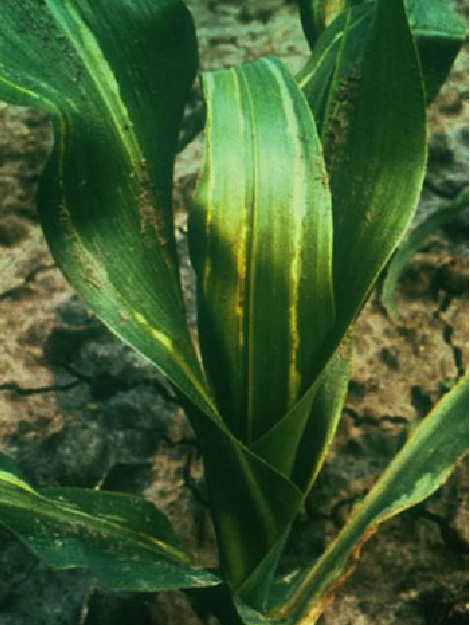Bacterial wilt of maize
Pantoea stewartii f. sp. stewartii
Damage symptoms

Infected young plants wilt quickly and die. Yellow to brown, elongated stripes appear on the leaves. Small cavities form in the stem, which are brownish to dark brown in color. On cut surfaces of stems of infected plants that have been cut apart and on injured areas of infected leaves, the bacteria emerge in the form of yellow mucilage droplets. In sweet corn, susceptible hybrid varieties wilt very quickly and also show the typical leaf symptoms. In grain corn, hybrid varieties are generally resistant to the wilt stage but susceptible to leaf wilt. The bacteria penetrate deeply into seeds but not into the embryo.
Host plants
The main host of the bacterium is corn. Sweet corn varieties are particularly affected. However, grasses (Poaceae) grown mainly for forage in North America, e.g. Tripsacum dactyloides, Setaria lutescens and teosinte(Zea mays ssp. mexicana), are also affected.
Job's tears(Coix lachryma-jobi), red bristle millet(Setaria pumila), and Zea perennis could also be artificially infected for research purposes. Several weeds from the Poaceae family are symptomless host plants of Pantoea stewartii ssp. stewartii.
Distribution
Stewart's bacterial wilt was first detected in the USA, on Long Island, in 1897. There were major crop losses in the USA in the 1930s. Since then, only sporadic occurrences have occurred due to the cultivation of more and more resistant varieties.
This corn disease has also been detected in Brazil, Canada, China, Costa Rica, Malaysia, Mexico, Puerto Rico, Italy, Guyana, Peru, Poland, the former Soviet Union, Romania, Thailand, and Vietnam. Reports of positive detections have also been received from Austria.
Propagation and transmission
Internationally, Stewart's bacterial wilt is principally transmitted and spread in or on infected seed. Local transmission of the disease is by insects acting as vectors, which transfer the bacteria into the plants by feeding on them. In North America, Chaetocnema pulicaria (a grain ground flea) is the main vector, as well as the northern corn rootworm (Diabrotica longicornis) and the seed fly(Phorbia cilicrura). The bacteria survive in the digestive tracts of the overwintering beetles.
Phytosanitary status
Pantoea stewartii subspecies stewartii is listed as a Union aquatic pest and is thus subject to legal regulations to prevent its introduction and spread into or within the member states of the EU.
Last updated: 29.08.2024
automatically translated